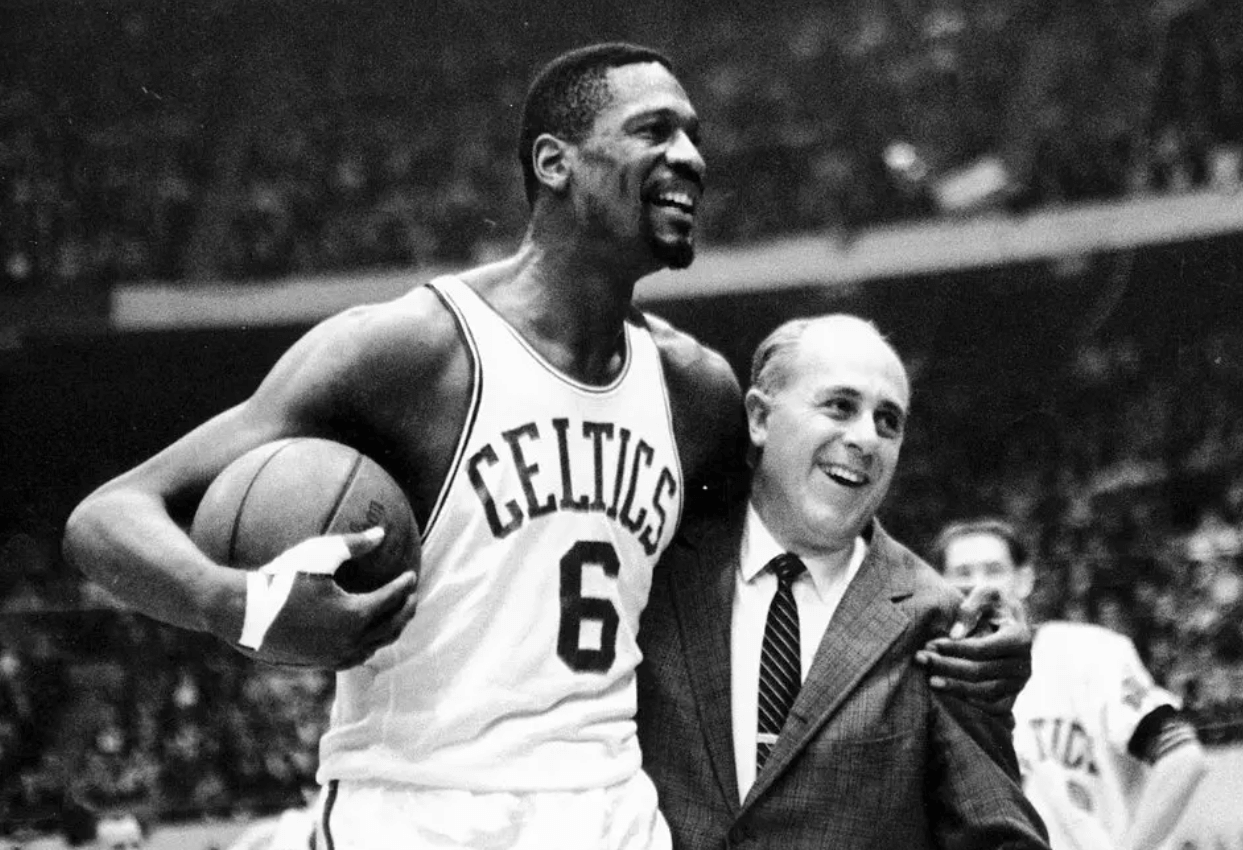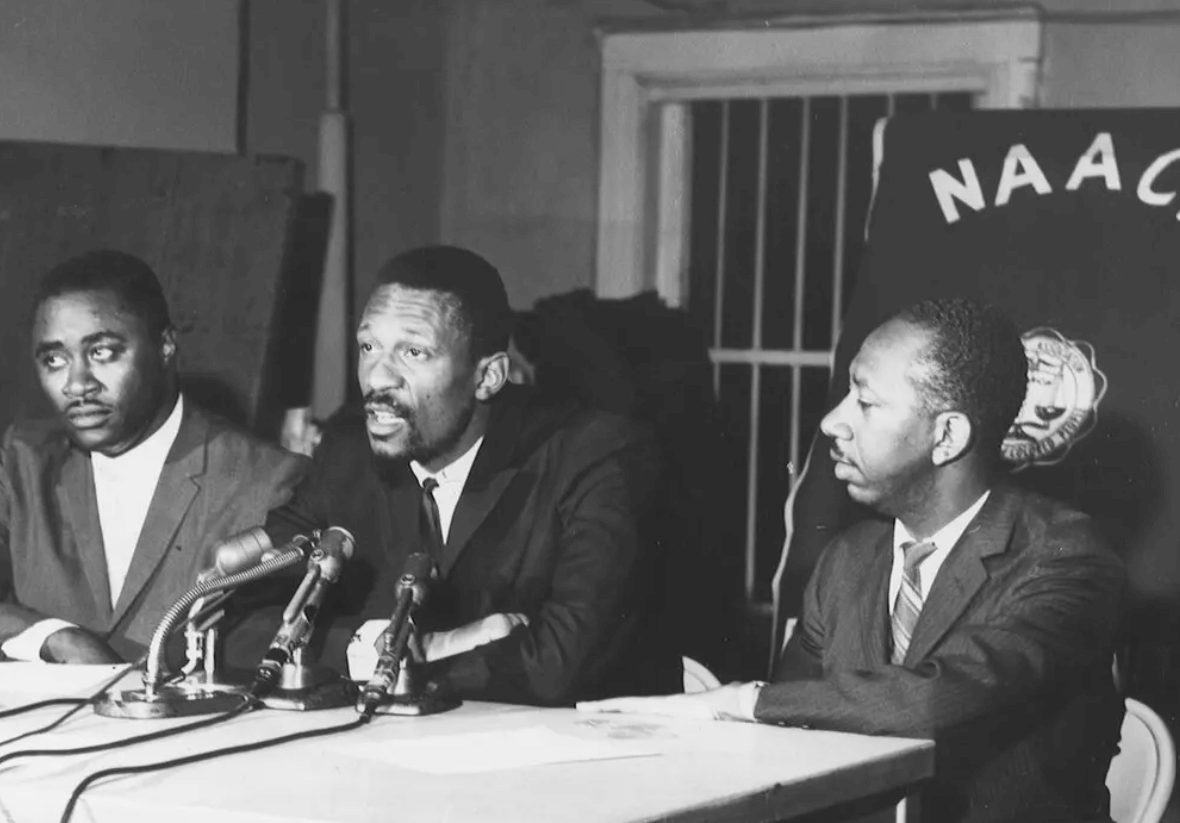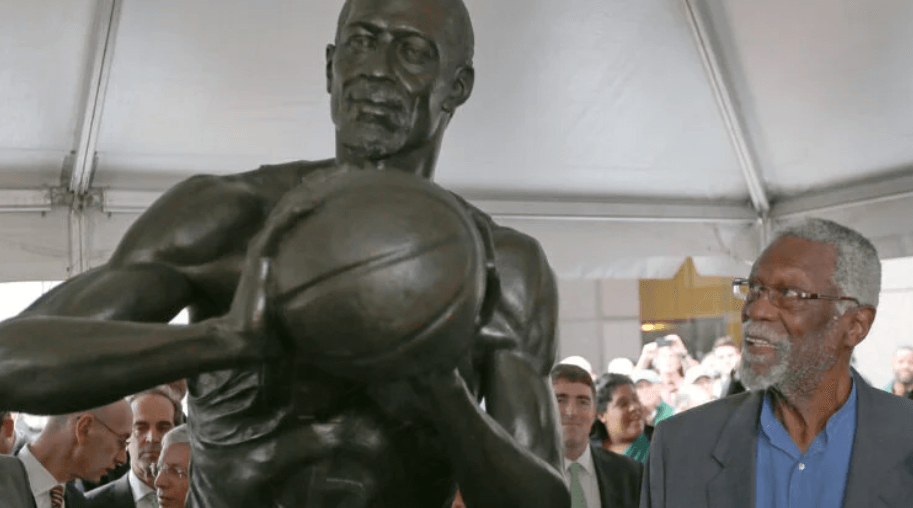Bill Russell
From 1956-1969, Bill Russell won eleven championships in thirteen seasons with the Boston Celtics, playing at the Boston Garden in the historic West End. Russell’s activism on and off the court advanced social justice and made him a role model for many athletes today.
Bill Russell was born on February 12, 1934 in Monroe, Louisiana. When Russell was eight years old, he and his family moved to Oakland, California where his father, Charles, and mother, Katie, worked at a shipyard during World War II. After Katie Russell died of a flu-like illness when Bill was twelve, Russell looked up to his father as a role model while seeking to fulfill his mother’s dream that he attend college. Russell made the high school basketball team after a growth spurt where he became 6’9”, and during that time he crafted his method, uncommon at the time, of jumping high to block shots. The University of San Francisco was the only college that recruited Russell, though he led USF (alongside K.C.Jones, his future teammate in Boston) to consecutive NCAA titles in 1955 and 1956. In 1956, Red Auerbach’s Boston Celtics selected Bill Russell in the NBA Draft, but only after Auerbach made creative deals to give the Celtics the opportunity. When the Celtics drafted Tommy Heinsohn, a star forward from Holy Cross, as the “territorial pick” (giving teams preferential access to an athlete from a local college) in 1956, they had to forfeit their first-round selection that year. Auerbach was able to draft Russell in addition to Heinsohn by making two moves. First, the Celtics traded Ed Macauley to the St. Louis Hawks for the second overall pick in the draft. And second, the Celtics convinced the owner of the Rochester Royals to agree not to draft Russell with the first overall pick on the condition that the Ice Capades, an entertainment troupe partly owned by Celtics founder Walter Brown, would perform multiple shows at Rochester’s arena. Russell did not start playing for the Celtics right away, as he joined K.C. Jones again to win an Olympic gold medal with the U.S. Men’s Basketball Team, at the 1956 Olympics in Melbourne, Australia. But when he returned to the States, Russell was instrumental to the Celtics winning their first NBA championship in 1956, and then many more.
Russell’s major contributions to the Celtics, such as when he scored his 10,000th point in December 1964, took place at the Boston Garden in the historic West End. As Russell led his team to many victories, and frequently battled rival center Wilt Chamberlain, the Celtics won eleven championships in thirteen seasons. That unmatched dynasty includes eight consecutive NBA titles, from the 1959 to 1966 seasons. In the final three seasons of Russell’s career, 1966-1969, he served as “player-coach.” This meant that Russell, while playing for the team, simultaneously served as head coach. Calling timeouts and leading team huddles, Russell became the first Black head coach in NBA history. Russell, for his career, averaged 22.5 rebounds per game, was a five-time MVP, and twelve-time All-Star. Russell undoubtedly had many fans because of these accomplishments, but he also experienced a substantial amount of racism during his time in Boston. In 1987, Russell’s daughter, Karen, wrote an essay for The New York Times in which she described one incident where racists vandalized the Russell family home in Reading, MA. The vandals smashed Russell’s trophy case, spray-painted a racist slur on the wall, and defecated in the bed of Russell and his then-wife Rose Swisher. Russell responded to this and other instances of racism he experienced through participation in the civil rights movement. Russell participated in the 1963 March on Washington, and organized with the Boston NAACP against school segregation in the city.
Russell’s social justice organizing also took place on the court, where he led efforts by NBA players to improve their working conditions. Just before the Boston Garden was to host the All-Star Game on January 14, 1964, Russell and his fellow All-Stars met in the Celtics locker room to discuss going on strike (not playing the game) to demand that the NBA provide pensions to the players. Team owners initially promised pensions in meetings with the National Basketball Players Association in 1957, when players first considered a strike at the All-Star Game, but the players felt short-changed after seven years of no progress. After the NBA’s president, J. Walter Kennedy, approached the All-Stars and promised that he would deliver on pensions to ward off the strike threat, the players debated their next steps. Russell was a strong advocate for persisting with a strike to put pressure on the league to fulfill its promises, whereas Wilt Chamberlain and others voted to play the game. After a short delay, the All-Star Game proceeded as normal without a strike. However, because of grassroots pressure by Russell and others, the NBA began to provide pensions to its athletes in 1965.
Russell resisted having his jersey number, 6, retired by the Celtics in a grand public ceremony because of the fraught, love-hate relationship he had with the Boston fan base, by which he was commended but, at other moments, faced with racism. But Red Auerbach was insistent that the Celtics legend get his number raised to the rafters one way or another. In 1972, when Russell, then an ABC commentator, happened to be in Boston to call a nationally televised Celtics game, he and Auerbach agreed that his number would be retired only if it took place in a private ceremony before the game. The only people in attendance, other than a handful of arena staff and reporters who happened to be in the building, were Russell, Auerbach, head coach Heinsohn, and active Celtics players who were once Russell’s teammates. But in 1999, Russell participated in a public ceremony, with a sold-out crowd and NBA legends including Wilt Chamberlain in attendance, to re-dedicate his #6 at the Fleet Center (present-day TD Garden, built nine inches apart from the original Boston Garden vacated in 1995). In 2013, Boston erected a statue of Bill Russell at City Hall Plaza to honor his legacy as one of the greatest American athletes. Russell passed away at the age of 88 on July 31, 2022. The Boston Celtics issued a thoughtful statement after his death that aptly summarizes Russell’s life: “To be the greatest champion in your sport, to revolutionize the way the game is played, and to be a societal leader all at once seems unthinkable, but that is who Bill Russell was.”
Russell entered the Basketball Hall of fame as a player in 1975, and as a coach in 2021. His number, 6, became the only jersey retired across the entire NBA on August 11, 2022.
Article by Adam Tomasi, edited by Sebastian Belfanti
The author thanks Nick Collins at The Sports Museum of New England for conversations and insights which shaped this article.
Source: New York Times (obituary; Karen Russell essay; 1964 strike); WBUR; Britannica; Thomas Whalen, Dynasty’s End (Google Books); Boston.com; NBA; ESPN










